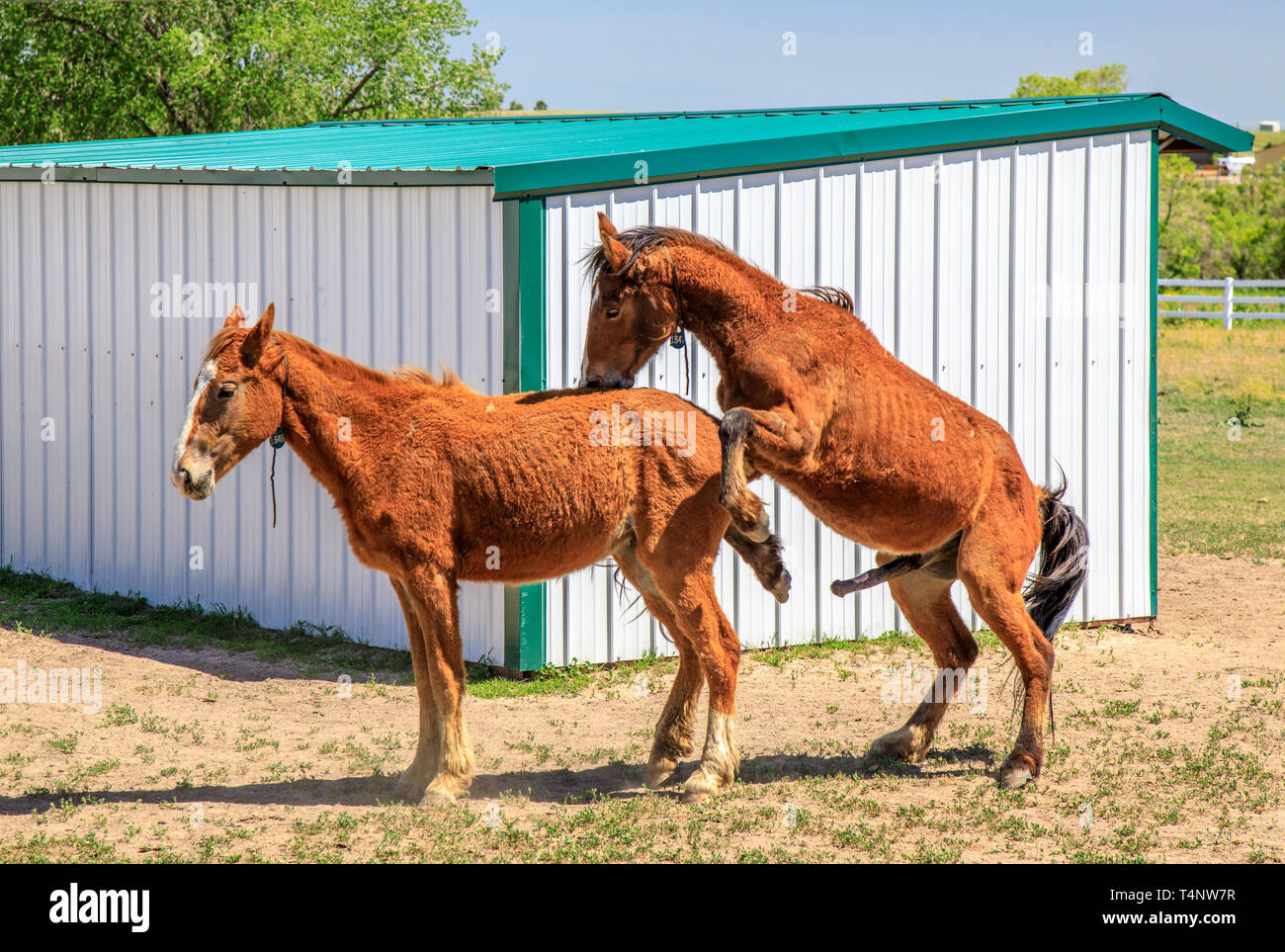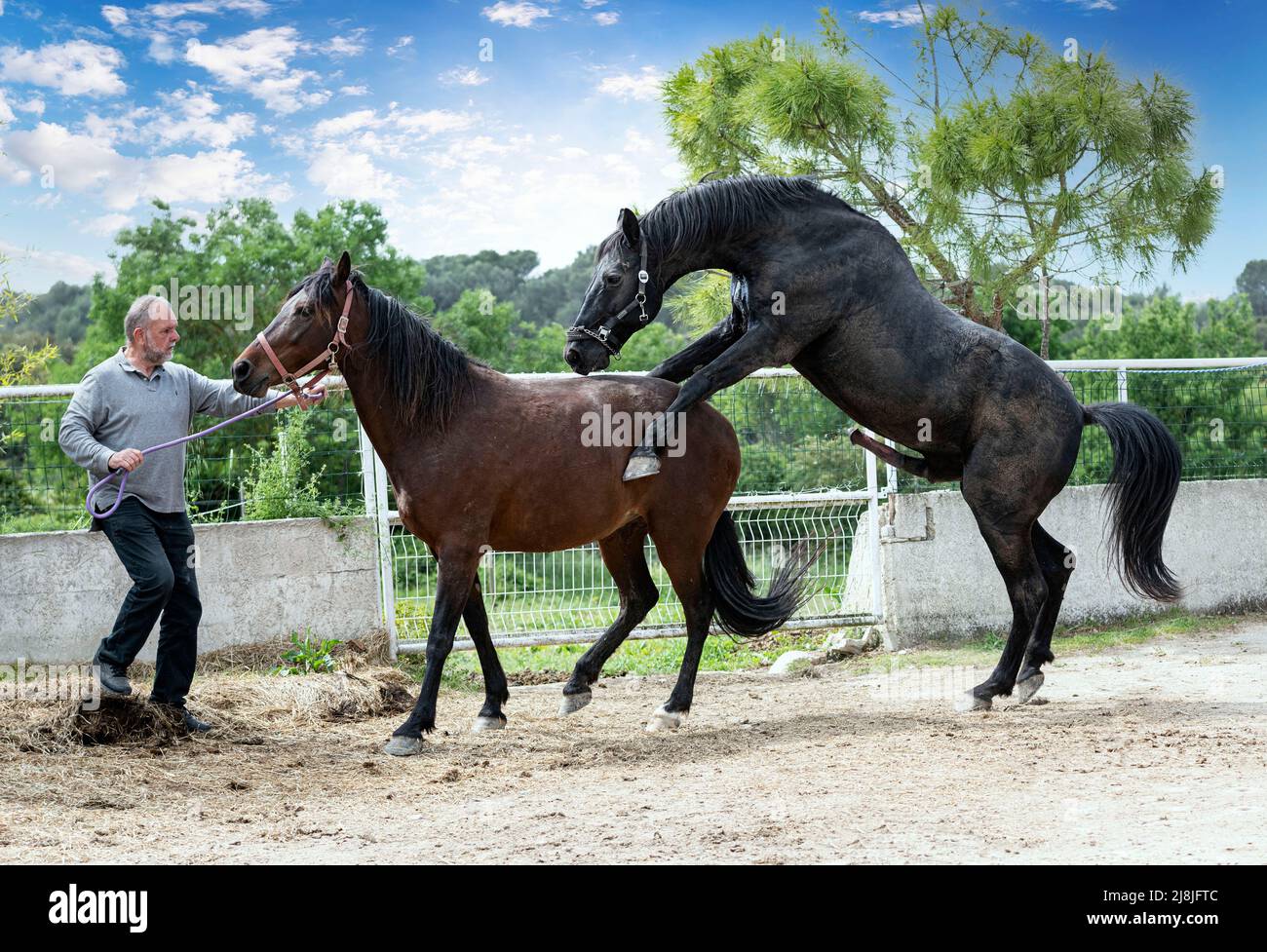How do these magnificent creatures, the horses, perpetuate their lineage? The process of horse mating, a captivating blend of instinct, biology, and behavior, is a natural and essential aspect of equine life.
For those curious to witness this intricate dance, a short video on Amanda Murray's channel provides a glimpse into the world of horse reproduction. The video features a stallion named Beau Brunswick Colt and a mare named Lucky Boy, and has garnered over 12 million views. This widespread interest underscores the fascination surrounding this topic, appealing to horse breeders, enthusiasts, and anyone curious about the natural world. The mating process, whether viewed in a video or observed in person, offers valuable insight into the reproductive behavior of these animals.
| Aspect | Details |
|---|---|
| Definition | Horse mating, also referred to as horse breeding, is the natural process by which horses reproduce sexually. It involves the stallion (male) and the mare (female) coming together for the purpose of reproduction. |
| Key Players | Stallions and mares are the primary actors in this process. Stallions are typically ready to mate throughout the year, but the timing depends heavily on the mare's estrus cycle. |
| Biological Readiness | The mating process is driven by instinct and biological readiness, including the mares heat cycle. This readiness is signaled through various behaviors and physiological changes. |
| Courtship Ritual | Courtship involves a series of behaviors, often initiated by the stallion to establish dominance and assess the mare's readiness. |
| Stages of Mating | The process includes several stages, from courtship to conception. The mares behavior signals her receptiveness, while the stallion tests her readiness through playful horseplay and other interactions. |
| Anatomy Overview | Understanding the reproductive anatomy of both the stallion and the mare is crucial. This includes the basic anatomical structures involved in the process. |
| Reproductive Cycles | The estrus cycle (heat cycle) of the mare is a critical biological factor, influencing the timing of mating. Mares show signs of heat to signal their readiness. |
| Breeding Techniques | While natural mating is common, techniques such as artificial insemination can optimize breeding success and promote horse welfare. |
| Health Considerations | The timing of the mating process affects the health of both the mare and the foal. Careful management is essential for the well-being of the animals. |
| Expertise | Equine experts play a vital role in domestic horse breeding, utilizing their knowledge and expertise to ensure successful outcomes. |
| Selective Breeding | Selective breeding is an important aspect of horse breeding. |
| Wild vs. Domestic | Horse mating in the wild may include distinct phases. Natural pasture mating is common. |
| Gestation | The entire process extends to gestation following conception. |
| Importance of Observation | Observing the behaviors and communication of horses provides valuable insights into the mating process. |
| Animal Communication | Understanding equine behavior through animal communication is relevant. |
| Mating Behaviors | The mating process involves a series of behaviors and interactions between a stallion and a mare. |
For further detailed information, you can refer to reputable sources such as the American Association of Equine Practitioners (AAEP). This organization provides extensive resources on all aspects of equine health and management.
- Martin Truex Jrs New Chapter From Sherry To Engagement Beyond
- Arzaylea News Dating Relationships In 2025 Beyond
The journey of horse mating is a complex and fascinating one, driven by instinct, biology, and the environment. Horse mating, a delicate process, requires careful management and understanding. It involves a series of behaviors and interactions between two horses. The male horse (stallion) and the female horse (mare) come together for breeding, a process that, while natural, necessitates attention to detail for successful outcomes.
The mating process of horses unfolds in a series of interconnected steps. It begins with the courtship ritual, where the stallion attempts to win the mare's favor. The mare's estrus cycle is pivotal, indicating when she is receptive. Stallions often engage in behaviors to establish dominance and assess the mare's readiness. This process often involves playful horseplay, a natural part of the courtship. The natural behaviors exhibited by stallions and mares during mating season offer a fascinating glimpse into the world of equine courtship. The timing of the mating process directly affects the health of the mare and foal, therefore is an important factor to consider during breeding.
Mares show signs of heat to signal their readiness to mate. Stallions, for their part, test this readiness, often through scent and physical contact. Understanding the intricacies of equine reproductive anatomy, the breeding cycle of horses, and various equine breeding practices is crucial for breeders and horse enthusiasts alike. During the mating process, the stallion will mount the mare, and copulation will occur. The physical act is important; however, it is only one part of a larger process. The mare may fall after mating. The basic reproductive anatomy, communication, and the four stages of the process are integral components of this natural behavior. The mating process also includes the basics of horse reproduction, the role of hormones, and exploring the mating process itself.
- Chelsea Clinton Stocks Holdings Net Worth Investments In 2024
- Rory Feek Finds Love Again A Heartwarming New Chapter
Artificial insemination offers an alternate approach, with several benefits. Artificial insemination techniques can be used to optimize breeding success and promote horse welfare. The process necessitates expertise from equine specialists and careful consideration of selective breeding and the reproductive system. The ability to control and guide the process, rather than solely relying on natural instincts, provides benefits.
Gaining knowledge about these anatomical structures forms the basis for understanding the process of horse mating. The mating process is a captivating aspect of equine biology and behavior. It is a critical aspect of domestic horse breeding. Whether through natural breeding or artificial insemination, the process requires expert knowledge. This approach involves several stages and behaviours that facilitate the transfer of sperm from the male to the female, ultimately leading to fertilization and the creation of offspring. The process also considers selective breeding for optimal traits.
The role of stallions and mares in horse breeding is vital. The process ensures the continuation of the equine species. Proper management is essential to maintain health. A comprehensive understanding of the mating process is essential for horse breeders and enthusiasts alike. It involves a detailed understanding of the behaviors and communication of the horses involved, as well as the physical act of copulation. This includes the behaviors and physiological changes which accompany the act. The details of how these majestic animals mate is a topic of fascination.
Horse mating is an essential part of horse breeding and is a fascinating process to observe. Natural mating rituals are important and are part of horse breeding techniques. From natural mating rituals to horse breeding techniques and the foaling process, the study of horse mating provides details for how these majestic animals reproduce. Observing the incredible natural mating process of horses in a traditional village setting provides additional context.
The mating process involves different stages of courtship, mating, and gestation. It is driven by instinct and environmental factors. The process should be handled and understood with care. This involves a detailed understanding of the behaviors and communication of the horses involved. Gaining knowledge about these anatomical structures forms the basis for understanding the process of horse mating. Horse mating in the wild and natural pasture mating is characterized by three distinct phases. Proper care facilitates breeding, ensuring the health of the horses involved.
Like most male mammals, stallions are willing and ready to mate throughout the year. The timing of the mating really depends on the female. Understanding the intricate parts of the process will provide valuable insights into the reproductive behavior of these animals. Learning about the horse's breeding cycle, sexual maturity, and mating behaviors provides deeper insight. The intricacies of horse mating play a vital role in the continuation of the equine species.
Horse mating, like mating in many other animals, is a natural process essential for reproduction. This natural process is a complex process that involves a series of behaviors and physical interactions. The process is also influenced by biological readiness. The horses breeding cycle, sexual maturity, and mating behaviors are all relevant factors.
In essence, horse mating is an intricate dance orchestrated by nature, biology, and behavior, a process that is essential for the survival and continuation of these magnificent creatures.
- Brett Eldredge Age Height Bio What You Need To Know
- Scheana Shays Net Worth In 2024 Unveiling Her Fortune


